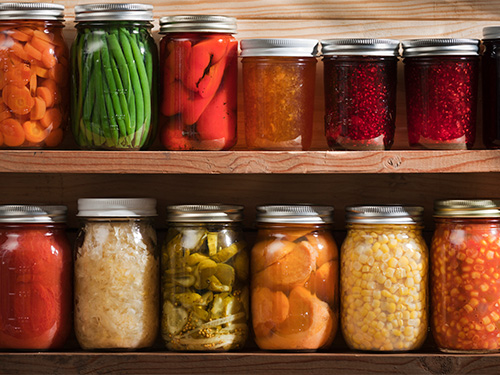The Basics of Canning
Sep 09, 2024

If you’ve perfected the art of growing tomatoes, green beans, and other produce, chances are you’re now facing an abundance of fresh food from your garden. Preserving your harvest using the tried-and-true method of home canning allows you to enjoy the fruits (and vegetables) of your labor all year long without worry of spoilage or contamination.
Whether you’re a beginner or just need a quick refresher, this guide will help you master the basics of home canning.
Step-by-Step Guide to Home Canning
Canning at home is both rewarding and straightforward when you follow these basic steps:
Water Bath Canning
Water bath canning is perfect for preserving high-acid foods like jams, pickles, and tomato sauces. This method involves placing filled jars on a rack in a large pot, covering them with hot water, and boiling them for a set amount of time. As the jars cool, a vacuum seal forms, preserving the contents. Foods suitable for this method include:
Pressure Canning
For low-acid foods like meats and vegetables, pressure canning is the way to go. Unlike water bath canning, this method uses steam in a sealed container to reach temperatures above 240 degrees Fahrenheit, which is necessary to kill harmful bacteria like Clostridium botulinum. Foods suitable for this method include:
Canning is a wonderful way to preserve your garden’s bounty, ensuring that you and your family can enjoy homemade, wholesome food throughout the fall and winter months. Ready to get started? Head over to your local Co-op for all the gardening and canning supplies you need to keep your pantry stocked. Availability varies by location.
Find your nearest Co-op location here. For more content like this, check out the latest issue of The Cooperator.
Whether you’re a beginner or just need a quick refresher, this guide will help you master the basics of home canning.
Step-by-Step Guide to Home Canning
Canning at home is both rewarding and straightforward when you follow these basic steps:
- Prepare the food and supplies: Start with freshly picked, clean produce that is free of disease or damage and prepare the food according to your recipe. Ensure you have enough jars, lids, and other ingredients on hand. Clean the jars and check them for any damage, then lay out all your supplies so everything is within easy reach. Add the necessary amount of hot water to your canner.
- Pack the jars: Following your recipe, fill each jar with food, making sure to leave the recommended amount of headspace. Add hot water as needed, wipe the rims clean, and apply the lids. Place each filled jar in the canner as you go.
- Process the jars: Process the jars according to the instructions specific to your canner and use a kitchen timer to time the process. For water bath canning, you can remove the jars right after processing, but with a pressure canner, you must wait for the pressure to decrease before safely opening it. Most modern pressure canners have safety features to prevent them from opening while under pressure.
Water Bath Canning
Water bath canning is perfect for preserving high-acid foods like jams, pickles, and tomato sauces. This method involves placing filled jars on a rack in a large pot, covering them with hot water, and boiling them for a set amount of time. As the jars cool, a vacuum seal forms, preserving the contents. Foods suitable for this method include:
- Fruits and fruit juices
- Jams and jellies
- Fruit sauces
- Pie fillings
- Acidified tomatoes
- Tomato-based salsas
- Pickles and relishes
- Vinegar-based condiments
Pressure Canning
For low-acid foods like meats and vegetables, pressure canning is the way to go. Unlike water bath canning, this method uses steam in a sealed container to reach temperatures above 240 degrees Fahrenheit, which is necessary to kill harmful bacteria like Clostridium botulinum. Foods suitable for this method include:
- Meats, poultry, and seafood
- Vegetables
- Root crops like beets and potatoes
- Dried beans
- Stocks and broths
- Chili, soups, and stews
Canning is a wonderful way to preserve your garden’s bounty, ensuring that you and your family can enjoy homemade, wholesome food throughout the fall and winter months. Ready to get started? Head over to your local Co-op for all the gardening and canning supplies you need to keep your pantry stocked. Availability varies by location.
Find your nearest Co-op location here. For more content like this, check out the latest issue of The Cooperator.